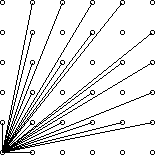标签:
http://poj.org/problem?id=3090
| Time Limit: 1000MS | Memory Limit: 65536K | |
| Total Submissions: 6153 | Accepted: 3662 |
Description
A lattice point (x, y) in the first quadrant (x and y are integers greater than or equal to 0), other than the origin, is visible from the origin if the line from (0, 0) to (x, y) does not pass through any other lattice point. For example, the point (4, 2) is not visible since the line from the origin passes through (2, 1). The figure below shows the points (x, y) with 0 ≤ x, y ≤ 5 with lines from the origin to the visible points.

Write a program which, given a value for the size, N, computes the number of visible points (x, y) with 0 ≤ x, y ≤ N.
Input
The first line of input contains a single integer C (1 ≤ C ≤ 1000) which is the number of datasets that follow.
Each dataset consists of a single line of input containing a single integer N (1 ≤ N ≤ 1000), which is the size.
Output
For each dataset, there is to be one line of output consisting of: the dataset number starting at 1, a single space, the size, a single space and the number of visible points for that size.
Sample Input
4 2 4 5 231
Sample Output
1 2 5 2 4 13 3 5 21 4 231 32549
隐藏很深的一道欧拉函数题,观察下面这个图,将图分成上下两个三角形,观察下三角,横坐标从2开始,发现可以看到的点有(2,1), (3,1),(3,2), (4,1),(4,3), (5,1),(5,2),(5,3),(5,4)
从中可以发先一个规律可以看到的点的横坐标与纵坐标的关系是互质的,由此可以求出下三角横坐标互质的数的和ans,上三角和下三角同理,我们讨论时横坐标是从2开始的,我们忽略了三个点
(0,1),(1,0),(1,1)最后加上即可,最终总个数ans = ans * 2 + 3;

#include<stdio.h> #include<string.h> #include<math.h> #include<stdlib.h> #include<algorithm> using namespace std; int solve(int n) { int ans = n; for(int i = 2 ; i * i <= n ; i++) { if(n % i == 0) { ans = ans - ans / i; while(n % i == 0) n /= i; } } if(n > 1) ans = ans - ans / n; return ans; } int main() { int t, i, n, x = 0; scanf("%d", &t); while(t--) { x++; int ans = 0; scanf("%d", &n); int a = n; for(i = 2 ; i <= n ; i++) ans += solve(i); ans = ans * 2 + 3; printf("%d %d %d\n", x, a, ans); } return 0; }
poj 3060 Visible Lattice Points
标签:
原文地址:http://www.cnblogs.com/qq2424260747/p/4920457.html